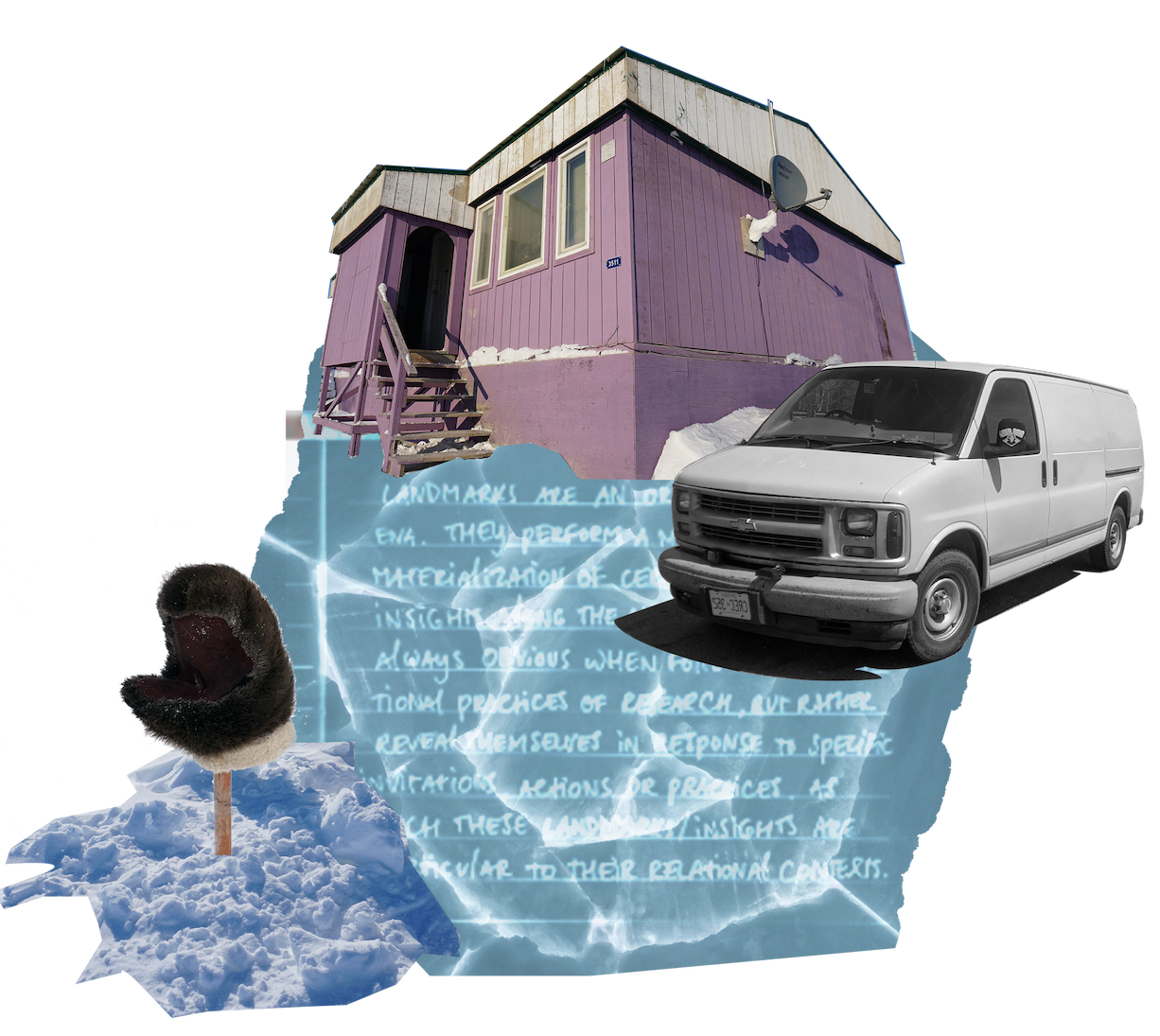The Great White Beast: Difference between revisions
No edit summary |
No edit summary |
||
| (10 intermediate revisions by the same user not shown) | |||
| Line 1: | Line 1: | ||
[[File:Landmark.png|thumb]] | [[File:Landmark small.png|thumb]] | ||
Mx. Science as a liminal figure, conjures many shapeshifting, associative frames, depending on who encounters them. Such an idea may potentially be put into dialogue with traditional Inuit beliefs and legends around the polar bear, which is sometimes traditionally referred to as the "Great White Bear", or the "Great White Beast" (Jimmy Qirqut, Gjoa Haven Elder, 2022). According to some of these legends, the polar bear is also a shapeshifting figure. Sometimes human, sometimes bear. | |||
Although some resonance can be found between Mx. Science and Inuit legends of shapeshifting polar bears, I have focussed on the how the liminal presence of Mx. Science can affectively and performatively invoked other "Great White Beasts". For example, the one of ever shapeshifting settler-colonialism, that continues to haunt polar bear management and monitoring and other Arctic-science spaces. Another figure that Mx. Science can be considered to invoke is the (Great White) "Beast" of the "polar bear problem",<ref>MacLean, J., Clark, S. G., Foote, L., Jung, T. S., Lee, D. S., & Clark, D. A. (2020). Polar Bears and the Politics of Climate Change: A Response to Simpson. Journal of International Wildlife Law & Policy, 23(2), 141-150.</ref> a "wicked problem" that is seemingly im/possible to "tame" <ref>Termeer, C. J., Dewulf, A., & Biesbroek, R. (2019). A critical assessment of the wicked problem concept: relevance and usefulness for policy science and practice. Policy and Society, 38(2), 167-179.</ref> | |||
<div class="next_choice">Mx. Science as such could be understood to engage with ICC's Protocol 3, directive 2 that points out the importance of addressing power dynamics. "... including those embedded in formal processes (...) within specific settings, approaches, processes and work.<ref>Inuit Circumpolar Council (2022). Circumpolar Inuit Protocols for Equitable and Ethical Engagement.</ref>"</div> | |||
<small><references /></small> | |||
<span class="return to-cut-2 link" data-page-title="Point of Beginning Mx. Science" data-section-id=" | <span class="return to-cut-2 link" data-page-title="Point of Beginning Mx. Science" data-section-id="8" data-encounter-type="return">[[Point of Beginning Mx. Science#Another Point of Beginning|Return to Cut 2: "Mx. Science"]]</span> | ||
Latest revision as of 12:54, 18 July 2025

Mx. Science as a liminal figure, conjures many shapeshifting, associative frames, depending on who encounters them. Such an idea may potentially be put into dialogue with traditional Inuit beliefs and legends around the polar bear, which is sometimes traditionally referred to as the "Great White Bear", or the "Great White Beast" (Jimmy Qirqut, Gjoa Haven Elder, 2022). According to some of these legends, the polar bear is also a shapeshifting figure. Sometimes human, sometimes bear.
Although some resonance can be found between Mx. Science and Inuit legends of shapeshifting polar bears, I have focussed on the how the liminal presence of Mx. Science can affectively and performatively invoked other "Great White Beasts". For example, the one of ever shapeshifting settler-colonialism, that continues to haunt polar bear management and monitoring and other Arctic-science spaces. Another figure that Mx. Science can be considered to invoke is the (Great White) "Beast" of the "polar bear problem",[1] a "wicked problem" that is seemingly im/possible to "tame" [2]
- ↑ MacLean, J., Clark, S. G., Foote, L., Jung, T. S., Lee, D. S., & Clark, D. A. (2020). Polar Bears and the Politics of Climate Change: A Response to Simpson. Journal of International Wildlife Law & Policy, 23(2), 141-150.
- ↑ Termeer, C. J., Dewulf, A., & Biesbroek, R. (2019). A critical assessment of the wicked problem concept: relevance and usefulness for policy science and practice. Policy and Society, 38(2), 167-179.
- ↑ Inuit Circumpolar Council (2022). Circumpolar Inuit Protocols for Equitable and Ethical Engagement.
